The problem:
star images appear elongated when shooting CCD luminance images at
low elevation. It seems that that this problem has not been widely discussed
and may not be widely recognised. In CCD images it looks exactly like a trailing
problem to do with low elevation turbulence (declination reversals) or a flexure
problem, and this is what I assumed it to be. It has plagued my low elevation
images for the past year - in the summer of 2001 I came away from a two week
astro trip with hardly any result owing directly to this problem. I have discussed
it with many people and in every case it was assumed to be due to either flexure
or low elevation turbulence.
Flexure or low elevation turbulence?::
I grappled with this problem for over a year and took almost every conceivable
step to eliminate these causes. The clue that it is not due to these
causes is when elongated stars appear in 2 second grab shots for focusing!
Or when 2 second guide star images are clearly elongated! Finally I wrote
to Roland Christen who replied with the following:
"Yes, of course, I get elongation at low altitudes all the time with
my 10" Mak. It does not matter if the exposure is 10 minutes, 10 seconds
or 0.1 seconds. Can you guess from that what it is?
Hint: the elongation is always in the direction of 90 degrees from the horizon,
so when shooting south, it will be in Dec. When shooting East or West, it
will be in RA."
Those two paragraphs are etched in my memory. I hope that Roland's advice
may help others in the same way that it helped me. My thanks also to Ron Wodaski
for confirming the cause of the problem.
Why shoot at low elevation?
Results at high elevation are much better. But sometimes low elevation
objects are so compelling that they are hard to resist. Example: the southern
summer Milky Way is rich in some of the most wondrous objects in the entire
night sky: M8, M20, M16, M17... Many of these are so low in the south that
they cannot be imaged with any quality from the UK. Hence when in southern
France I make a bee-line for them. But even from there the objects are very
low (M8 skims the horizon at 20 degrees elevation). Conclusion: I cannot reasonably
escape the problems inherent in low elevation imaging - they are still there
even after travelling 800 miles south.
The cause: The
atmosphere refracts light, and the more atmosphere that the light passes through,
the more it gets refracted. However the atmosphere is not achromatic <g>
Hence the light is also spectrally dispersed - we see an elongated star image
that consists of the star's spectrum, from blue through to deep red. But since
the CCD is a monochrome device we do not see the colours - we see only an
elongated star image. CCD sensors are particularly prone to this problem because,
as well as recording the visible spectrum, they are sensitive deep into the
infra-red. This problem shows up differently in colour film because the film
shows the dispersed spectrum in colour. Hence instead of elongated stars we
see "prismatic" stars, the appearance of which is identical to chromatic
aberration (it is in fact chromatic aberration, but it is caused by the atmosphere
rather than the optical system). Colour film exhibits the problem to a lesser
degree than a CCD because of film's insensitivity to IR.
The cure: There is not a complete cure.
Naturally the problem affects unfiltered (luminance) images most of all. The
problem would be lessened to a degree with a clear filter that had an IR block.
SBIG's CFW-8 clear filter does not have such a block. Even so, the problem
would remain a substantial one. The optimum solution (though still not a complete
one as I show below) is to shoot high resolution tri-colour (through RGB filters
without luminance frames). This lessens the problem for the same reason as
with colour film: each filtered image contains a sufficiently small fragment
of the spectrum that the amount of spectral dispersion in each image is small.
The RGB filters in SBIG's CFW-8 have an IR block which also helps a great
deal.
Examples:
Two broadband luminance images taken about 4 hours apart...
The star elongation changes direction between the two images! The direction
of star elongation is always perpendicular to the horizon. |
|
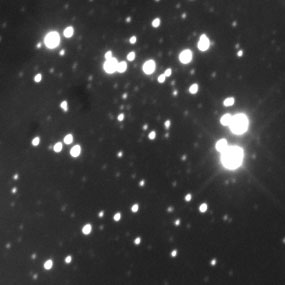
|
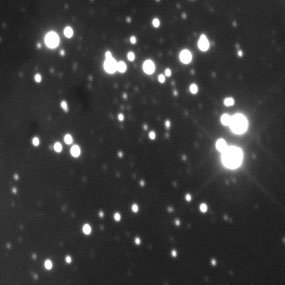
|
|
M16 near the eastern horizon
|
M16 one hour past the meridian
|
|
| |
|
|
| The problem starts to get better.. a sequence of images taken
(in poor seeing) through RGB tri-colour filters |
|
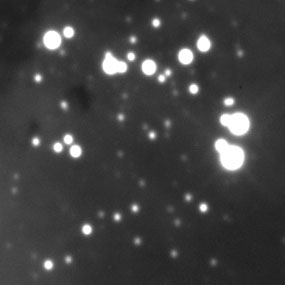
|
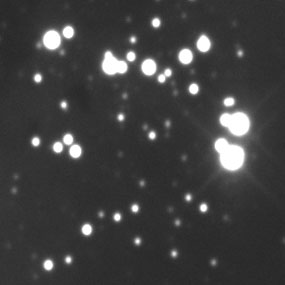
|
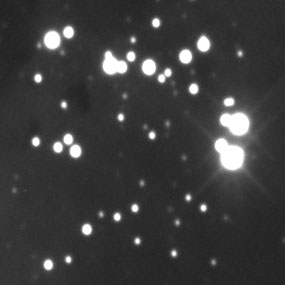
|
|
Red Filter
|
Green Filter
|
Blue Filter
|
| The elongation is least with the red filter, greater with
the green filter, and greatest with the blue filter. It seems that the green
and blue filters are passing parts of the spectrum that show greater refraction.
The elongation shows up more after the images have been DDP'd - perhaps
I should have done that. |
| |
|
|
| The above red-filtered image appears to have hardly any star
elongation. However it was taken in poor seeing. In good seeing some slight
elongation can still be seen. See below... |
|

|
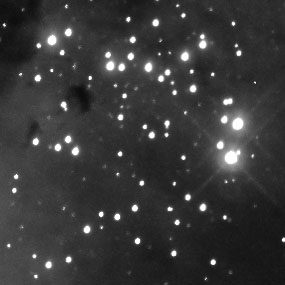
|
|
|
Red filtered image in good seeing -
still not too bad perhaps?
|
...except that by the time the image
is DDP'd and deconvolved enough elongation becomes visible to determine
the plane of the horizon!
|
|
| |
|
|
As a more refined illustration I have taken the above top
left image and applied DDP to show the shape of the stars more clearly.
Now the classic "tear drop" shape of the stars can be seen. Stan
Moore described the cause (in his post to SBIG dated 27 June) as follows:
The blue portion (of the "spread") is subject to severe
atmospheric extinction and poor QE. So the actual "spread" will
not be constant and will result in a "tear drop" star shape that
varies according to star color (red stars will be much rounder than blue
stars). |
|
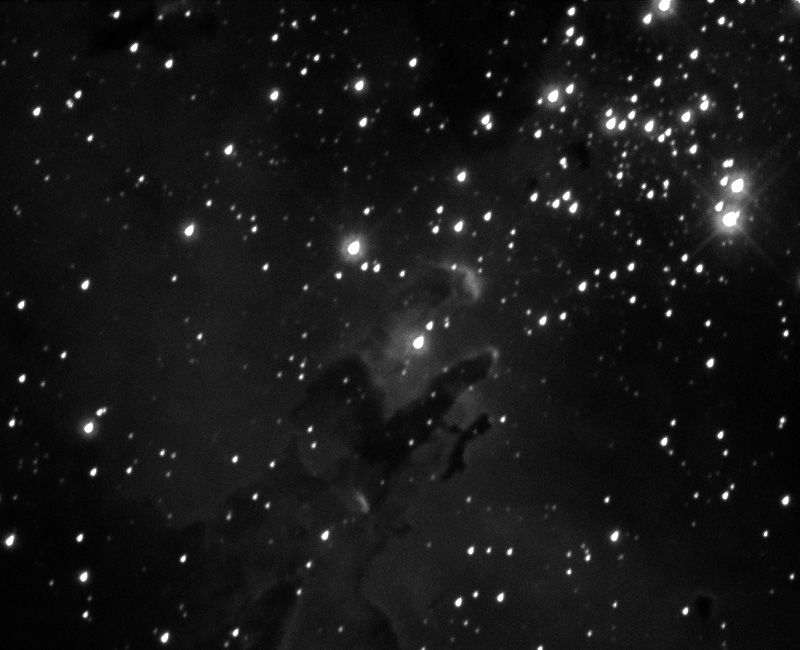
|
| The medium brightness stars show the shape most clearly..
have you seen stars like this in low elevation luminance images and attributed
the cause to poor tracking (through low elevation turbulence) or flexure
/ balance problems? Have you (so far) been unable to find the true cause? |
So it seems that there is no complete cure. However a passable end result
can be had by shooting pure RGB images and making slight adjustments to each
image before combining the stack. An example is my finished version of M16
which was re-imaged using only RGB filters (without luminance frames).
Update - April 2008: Recent experiences with
the STL-11K (acquired September 2007) show that spectral dispersion is significantly
lower - it is still present but much less of a problem. This may explain why
some people reported not seeing the problem - it depends to a large extent
on the spectral bandpass of the camera. The ST-8E has a broad bandpass - the
QE maximises in the red part of the spectrum and has a long tail that extends
into the infra-red. Whereas the STL-11K has a much narrower bandpass with
a QE that maximises in the blue/green and tails off rapidly into the red.
Light at low elevation is strongly red biased because blue light is abosorbed
by the thick layers of atmosphere, resulting in highest ADU counts by the
highly red-sensitive ST-8E, much less so in the case of the STL-11K.
All text and images Copyright © 1997-2022 by Philip
Perkins. All rights reserved.







